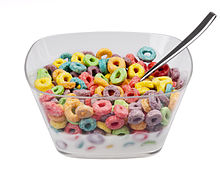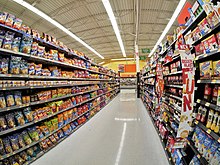
Back Alimento ultraprocesado Spanish خوراک فوق فرآوری Persian Aliment ultratransformé French Cibi ultralavorati Italian Cibus nimis machinatus Latin Ultrabewerkte voeding Dutch Ultraprosessert mat NB Alimentos ultraprocessados Portuguese Ultra-processed food SIMPLE Ультраоброблена їжа Ukrainian
This article has multiple issues. Please help improve it or discuss these issues on the talk page. (Learn how and when to remove these template messages)
|


An ultra-processed food (UPF) is an industrially formulated edible substance derived from natural food or synthesized from other organic compounds.[1][2] The resulting products are designed to be highly profitable, convenient, and hyperpalatable, often through food additives such as preservatives, colourings, and flavourings.[3] UPFs have often undergone processes such as moulding/extruding, hydrogenation or frying.[4]
Ultra-processed foods first became ubiquitous in the 1980s,[5] though the term "ultra-processed food" gained prominence from a 2009 paper by Brazilian researchers as part of the Nova classification system.[6] As of 2024, research into the effects of UPFs is rapidly evolving.[7][4]
Epidemiological data suggest that consumption of ultra-processed foods is associated with higher risks of many diseases, including obesity, type 2 diabetes, cardiovascular diseases, asthma, specific cancers, and all-cause mortality.[8] Food addiction may also be associated with consumption of ultra-processed foods.[9] Ultra-processed foods make up a significant proportion of the diet of developed countries, varying from 10% in Romania to over 50% in the United Kingdom and the United States.[4]
Some authors have criticised the concept of "ultra-processed foods" as poorly defined, and the Nova classification system as too focused on the type rather than the amount of food consumed.[10]
- ^ Monteiro C (2010). "The big issue is ultra-processing". World Nutrition. 1 (6): 237–269. ISSN 2041-9775.
- ^ Monteiro C (2011). "The big issue is ultra-processing. Why bread, hot dogs – and margarine – are ultra-processed". World Nutrition. 2 (10): 534–549. ISSN 2041-9775.
- ^ Monteiro CA, Cannon G, Levy RB, Moubarac JC, Louzada ML, Rauber F, Khandpur N, Cediel G, Neri D, Martinez-Steele E, Baraldi LG, Jaime PC (2019). "Ultra-processed foods: what they are and how to identify them". Public Health Nutrition. 22 (5): 936–941. doi:10.1017/S1368980018003762. ISSN 1368-9800. PMC 10260459. PMID 30744710.
- ^ a b c Touvier M, Louzada ML, Mozaffarian D, Baker P, Juul F, Srour B (2023-10-09). "Ultra-processed foods and cardiometabolic health: Public health policies to reduce consumption cannot wait". BMJ. 383: e075294. doi:10.1136/bmj-2023-075294. ISSN 1756-1833. PMC 10561017. PMID 37813465.
- ^ Fardet A (2018), Characterization of the Degree of Food Processing in Relation With Its Health Potential and Effects, Advances in Food and Nutrition Research, vol. 85, Elsevier, pp. 79–129, doi:10.1016/bs.afnr.2018.02.002, ISBN 978-0-12-815089-4, PMID 29860978, retrieved 2024-05-17
- ^ Cite error: The named reference
Monteiro2010was invoked but never defined (see the help page). - ^ Cite error: The named reference
Lane2024was invoked but never defined (see the help page). - ^ Pagliai G, Dinu M, Madarena MP, Bonaccio M, Iacoviello L, Sofi F (2021-02-14). "Consumption of ultra-processed foods and health status: a systematic review and meta-analysis". British Journal of Nutrition. 125 (3): 308–318. doi:10.1017/S0007114520002688. ISSN 0007-1145. PMC 7844609. PMID 32792031.
- ^ LaFata EM, Gearhardt AN (2022-11-07). "Ultra-Processed Food Addiction: An Epidemic?". Psychotherapy and Psychosomatics. 91 (6): 363–372. doi:10.1159/000527322. ISSN 0033-3190. PMID 36349805.
- ^ Visioli F, Marangoni F, Fogliano V, Del Rio D, Martinez JA, Kuhnle G, Buttriss J, Da Costa Ribeiro H, Bier D, Poli A (December 2023). "The ultra-processed foods hypothesis: a product processed well beyond the basic ingredients in the package". Nutrition Research Reviews. 36 (2): 340–350. doi:10.1017/S0954422422000117. hdl:11577/3451280. ISSN 0954-4224.
© MMXXIII Rich X Search. We shall prevail. All rights reserved. Rich X Search